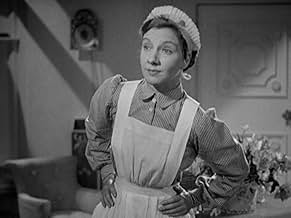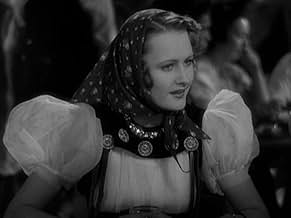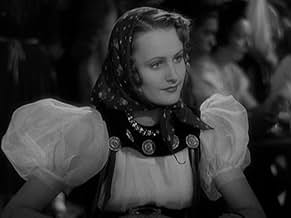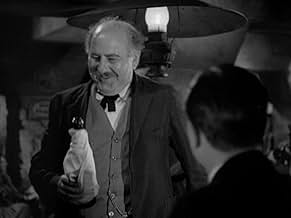IMDb-BEWERTUNG
6,3/10
1325
IHRE BEWERTUNG
Füge eine Handlung in deiner Sprache hinzuA lounge singer is sent by a count to pose as a wealthy socialite.A lounge singer is sent by a count to pose as a wealthy socialite.A lounge singer is sent by a count to pose as a wealthy socialite.
Mary Philips
- Maria
- (as Mary Phillips)
Rafael Alcayde
- Hotel Clerk
- (Nicht genannt)
Nino Bellini
- Cosmos Club Waiter
- (Nicht genannt)
Agostino Borgato
- Cordellera Bar Waiter
- (Nicht genannt)
Adriana Caselotti
- First Peasant Girl
- (Nicht genannt)
Robert Cauterio
- Hotel Clerk
- (Nicht genannt)
Irene Coleman
- Cosmos Club Hat Check Girl
- (Nicht genannt)
Gino Corrado
- Cosmos Club Croupier
- (Nicht genannt)
Empfohlene Bewertungen
Joan Crawford stars in "The Bride Wore Red," a 1937 MGM film based on the play by Ferenc Molnar. Here, it's directed by Dorothy Arzner. Arzner was a fascinating woman - a female director amid a sea of men - very much ahead of her time in her dress, profession, and lifestyle, and highly intelligent. Was she a great director? Hard for me to say. I don't think she always got the best scripts. And in Crawford, she had a headstrong star as well.
The story concerns a poor girl, Anni (Crawford) who sings in a sleazy café (read: with prostitution as a sideline)in the red light district of Trieste. A count she meets believes that the only thing separating the rich from the poor is money - it's not class, it's not breeding, it's not education. To make his point, he sends Anni to a fabulous resort with beautiful new clothes for two weeks. Anni meets Rudi (Robert Young), from an excellent and wealthy family, but he's engaged. With time short, Anni decides that it's Rudi she wants, and is determined to stick it out as long as necessary to get him. But it's not only a lack of funds and Rudi's fiancé standing in her way - it's also the postman, Giulio (Franchot Tone).
Crawford is beautiful, and this was the type of role she played continuously in the 1930s with great success. Tone, Young, and Billie Burke give her good support.
What is this business with the "no European accents" that someone mentioned? Actors do not use European accents when portraying foreigners in their own country or a nearby country. The characters aren't speaking English with a foreign accent in Poland, Switzerland, or Italy. They're speaking another language. If accents were necessary, all Chekov plays would be done with Russian accents. They aren't.
I thought for what this was, the film took a little too long to make its point and was a bit slow in spots. It's not the best Crawford film, but she gives a strong performance as a willful woman determined to marry money. As for Arzner's direction, apparently she couldn't get anywhere with Crawford, so I'll withhold judgment.
The story concerns a poor girl, Anni (Crawford) who sings in a sleazy café (read: with prostitution as a sideline)in the red light district of Trieste. A count she meets believes that the only thing separating the rich from the poor is money - it's not class, it's not breeding, it's not education. To make his point, he sends Anni to a fabulous resort with beautiful new clothes for two weeks. Anni meets Rudi (Robert Young), from an excellent and wealthy family, but he's engaged. With time short, Anni decides that it's Rudi she wants, and is determined to stick it out as long as necessary to get him. But it's not only a lack of funds and Rudi's fiancé standing in her way - it's also the postman, Giulio (Franchot Tone).
Crawford is beautiful, and this was the type of role she played continuously in the 1930s with great success. Tone, Young, and Billie Burke give her good support.
What is this business with the "no European accents" that someone mentioned? Actors do not use European accents when portraying foreigners in their own country or a nearby country. The characters aren't speaking English with a foreign accent in Poland, Switzerland, or Italy. They're speaking another language. If accents were necessary, all Chekov plays would be done with Russian accents. They aren't.
I thought for what this was, the film took a little too long to make its point and was a bit slow in spots. It's not the best Crawford film, but she gives a strong performance as a willful woman determined to marry money. As for Arzner's direction, apparently she couldn't get anywhere with Crawford, so I'll withhold judgment.
I've never been a fan of Joan Crawford, so it's always a surprise to find a performance of hers that really wins me over. I liked her in Grand Hotel (as 'Flaemmchen,') and I liked her again, very much, as Anni, the cheap night-club singer masquerading as a lady. Often seen in hard and brittle roles, Crawford has a very different look in this film, and expresses a vulnerability that brings her character to life. (Billie Burke is also notable, in the small but juicy role of the acid-tongued Contessa. And Franchot Tone has never been more likable.)
The Bride Wore Red is certainly built according to studio formula, but it also embodies all the earnest craftsmanship that characterized the studio system. The film at times seems clichéd, but it fully redeems itself through genuine empathy for the characters. And through its very strong premise: a 'scarlet' woman driven by hunger for the good life, who is given a slim chance of joining the upper class - provided she's cold and deceitful enough.
Until the final act, I really felt that the film could have gone either way: warm-hearted romance or bitter tragedy. The delicate balancing act makes it hard to achieve a satisfying pay-off. But the ending does succeed, thanks to a couple of nicely orchestrated scenes, and to the talent and charisma of Ms Crawford. These do make us believe that Anni could only choose as she does.
I was a bit sorry the film didn't delve just a little deeper into the moral and social dimensions. Anni's real problem is not what she wants, but rather what she may have to give up in order to get it. That distinction is not made entirely clear, leaving the film a bit too reliant on the old cliché that 'wealth doesn't bring true happiness.' But there's more going on here. Anni's 'tragic flaw' is not the hunger itself, but her willingness to give up honesty, morality and even true love. This distinction becomes almost subliminal, but it's there, and gives the film a slightly sharper edge. Anni is a character we can identify with and possibly admire, even when she's doing something despicable.
If you're in the mood for a traditional, old-style Hollywood entertainment, you won't go wrong with The Bride Wore Red. This is one of the good ones, a film I'd gladly watch again any time.
The Bride Wore Red is certainly built according to studio formula, but it also embodies all the earnest craftsmanship that characterized the studio system. The film at times seems clichéd, but it fully redeems itself through genuine empathy for the characters. And through its very strong premise: a 'scarlet' woman driven by hunger for the good life, who is given a slim chance of joining the upper class - provided she's cold and deceitful enough.
Until the final act, I really felt that the film could have gone either way: warm-hearted romance or bitter tragedy. The delicate balancing act makes it hard to achieve a satisfying pay-off. But the ending does succeed, thanks to a couple of nicely orchestrated scenes, and to the talent and charisma of Ms Crawford. These do make us believe that Anni could only choose as she does.
I was a bit sorry the film didn't delve just a little deeper into the moral and social dimensions. Anni's real problem is not what she wants, but rather what she may have to give up in order to get it. That distinction is not made entirely clear, leaving the film a bit too reliant on the old cliché that 'wealth doesn't bring true happiness.' But there's more going on here. Anni's 'tragic flaw' is not the hunger itself, but her willingness to give up honesty, morality and even true love. This distinction becomes almost subliminal, but it's there, and gives the film a slightly sharper edge. Anni is a character we can identify with and possibly admire, even when she's doing something despicable.
If you're in the mood for a traditional, old-style Hollywood entertainment, you won't go wrong with The Bride Wore Red. This is one of the good ones, a film I'd gladly watch again any time.
The plot may not be a novel one, but the title was appetising and so were the cast. 'The Bride Wore Red' was seen as part of one of many completest quests (seeing as many films not yet seen of the person in question as possible), this one being for Joan Crawford. As well as Crawford, we have other talented performers in Franchot Tone, Robert Young, George Zucco and Billie Burke. All of whom are great when with good material and in the right roles.
Although 'The Bride Wore Red' is not among the best of all involved (all have also been far worse served) or one of the best of the genre, it is still well worth watching and has a lot of positive traits. It didn't deserve to be a flop. As far as Crawford's 30s films go, which were a mixed lot in quality, 'The Bride Wore Red' somewhere around solid middle, and anybody that loves romance and comedy individually and together are likely to (not guaranteed as not everybody has the same tastes for everything) find a lot to enjoy. The case with me.
Is 'The Bride Wore Red' perfect? No. The story, despite the premise actually being good, has few surprises and can be very silly with some suspension of disbelief needed at times later on. Also felt that the start was on the dull side but once the main plot kicks in properly there is a lot more energy.
Do agree that Anni's conflict with what she wants and what she has to give up could have gone into more detail, that could have been a fascinating angle and added so much to Anni's character and given her more heart.
Crawford, looking stunning, however gives it her all without over-acting to the point of overbalancing the rest of the cast or film. She doesn't phone it in either once the plot gets going, despite being on the cold side at the beginning. Tone has one of the more likeable characters and is charming and suave. Young has some of the more juicier lines and brings a nice edge and sophistication to them. Zucco is convincingly decadent and Burke is in an atypically shrews viper sort of role and plays it to the hilt.
Found the script to be amusingly droll and that it did sparkle. The story wasn't perfect but it had energy and charm and the chemistry between the cast was beautifully pitched, the three leads work more than convincingly together. 'The Bride Wore Red' looks great, especially Crawford's wardrobe and the luminous photography. Franz Waxman's score is sumptuous without being too loud or melodramatic. Dorothy Azner's direction is a bit bland and slow to begin with, but becomes more assured as the film goes along.
Summing up, nice enough if not mind-blowing. 7/10
Although 'The Bride Wore Red' is not among the best of all involved (all have also been far worse served) or one of the best of the genre, it is still well worth watching and has a lot of positive traits. It didn't deserve to be a flop. As far as Crawford's 30s films go, which were a mixed lot in quality, 'The Bride Wore Red' somewhere around solid middle, and anybody that loves romance and comedy individually and together are likely to (not guaranteed as not everybody has the same tastes for everything) find a lot to enjoy. The case with me.
Is 'The Bride Wore Red' perfect? No. The story, despite the premise actually being good, has few surprises and can be very silly with some suspension of disbelief needed at times later on. Also felt that the start was on the dull side but once the main plot kicks in properly there is a lot more energy.
Do agree that Anni's conflict with what she wants and what she has to give up could have gone into more detail, that could have been a fascinating angle and added so much to Anni's character and given her more heart.
Crawford, looking stunning, however gives it her all without over-acting to the point of overbalancing the rest of the cast or film. She doesn't phone it in either once the plot gets going, despite being on the cold side at the beginning. Tone has one of the more likeable characters and is charming and suave. Young has some of the more juicier lines and brings a nice edge and sophistication to them. Zucco is convincingly decadent and Burke is in an atypically shrews viper sort of role and plays it to the hilt.
Found the script to be amusingly droll and that it did sparkle. The story wasn't perfect but it had energy and charm and the chemistry between the cast was beautifully pitched, the three leads work more than convincingly together. 'The Bride Wore Red' looks great, especially Crawford's wardrobe and the luminous photography. Franz Waxman's score is sumptuous without being too loud or melodramatic. Dorothy Azner's direction is a bit bland and slow to begin with, but becomes more assured as the film goes along.
Summing up, nice enough if not mind-blowing. 7/10
In about 1980 I saw this film at the UCLA Film Archives in a series presenting Dorothy Arzner directed films. There was a guest speaker at the event who was a personal friend of Arzner's. I don't remember her name, but she was introduced as, among other things, the writer for the script of "Craig's Wife" (1936; starring Rosalind Russell).
She said she was on the set for some of the shooting of "Bride Wore Red," and described how Joan Crawford was completely uncooperative with the director. Originally it was written for Luise Rainer but for some reason she was unavailable. "So they got Joan Crawford who wasn't anything like her," and was not suited for the film in this woman's opinion. While she was on the set she witnessed how Dorothy Arzner would gently make suggestions as to how to play a scene, "...and Joan would scream, 'You'll destroy me! You'll destroy me!' and she would run up to L.B. Mayer and he would say, 'There, there Joan, play it your way." So she did, "...and frankly, the film bombed. But when you have a star that is entirely uncooperative, you can't blame the director." I hope I have quoted this woman accurately. That is what has stuck in my memory. I am a big Crawford fan, but her flaws were apparently spectacular. I just thought it would be interesting to record this bit of info.
She said she was on the set for some of the shooting of "Bride Wore Red," and described how Joan Crawford was completely uncooperative with the director. Originally it was written for Luise Rainer but for some reason she was unavailable. "So they got Joan Crawford who wasn't anything like her," and was not suited for the film in this woman's opinion. While she was on the set she witnessed how Dorothy Arzner would gently make suggestions as to how to play a scene, "...and Joan would scream, 'You'll destroy me! You'll destroy me!' and she would run up to L.B. Mayer and he would say, 'There, there Joan, play it your way." So she did, "...and frankly, the film bombed. But when you have a star that is entirely uncooperative, you can't blame the director." I hope I have quoted this woman accurately. That is what has stuck in my memory. I am a big Crawford fan, but her flaws were apparently spectacular. I just thought it would be interesting to record this bit of info.
The Bride Wore Red is a ridiculous but fun film. A drunken count, slumming it for the night, runs into a cynical and hungry young woman, Anni Pavlovitch (Joan Crawford). He decides to send her on a luxury vacation to prove his drunken point that the poor and the rich aren't so different after all and buys her new clothes and arranges for her to stay in a luxury resort. Anni, who obviously thinks the whole thing is crazy, decides to go threw with it anyway. Arriving in the alps she meets Giulio (Crawford's real life husband, Franchot Tone) a very pert mail employee who immediately takes a shine to her. The two have sparks aplenty, but when she arrives at the hotel Anni quickly realizes that she would rather always have food on her table than the love of a good man, and quickly sets about seducing Rudi, a flighty engaged man who is very taken with her.
As with most romcoms the real test is if the chemistry works and here it does perfectly. Crawford and Tone have excellent chemistry here and he is very sweet and naive, persistently wearing down the jaded and bitter singer.
It's a lovely sweet film.
As with most romcoms the real test is if the chemistry works and here it does perfectly. Crawford and Tone have excellent chemistry here and he is very sweet and naive, persistently wearing down the jaded and bitter singer.
It's a lovely sweet film.
Wusstest du schon
- WissenswertesDuring filming, an electrician fell from the catwalk high above the set, narrowly missing the film's star, Joan Crawford. Shooting was temporarily halted while the man was rushed to hospital. Crawford refused to resume production until she was assured that the man would be fully cared for, that he would remain on salary, and that his family would be provided for. Crawford also called the hospital each day afterwards for reports on his condition.
- Zitate
Rudolph 'Rudi' Pal: In my opinion, most people prefer sardines to caviar because most people haven't tried caviar.
- Crazy CreditsDuring the opening credits, a music box is shown playing a tune in the background.
- VerbindungenFeatured in The Romance of Celluloid (1937)
- SoundtracksWho Wants Love?
(1937)
Music by Franz Waxman
Lyrics by Gus Kahn
Sung by Joan Crawford (uncredited) at the Cordellera Bar
Played throughout as part of the score
Top-Auswahl
Melde dich zum Bewerten an und greife auf die Watchlist für personalisierte Empfehlungen zu.
- How long is The Bride Wore Red?Powered by Alexa
Details
- Erscheinungsdatum
- Herkunftsland
- Sprache
- Auch bekannt als
- The Bride Wore Red
- Drehorte
- Österreich(Alpine exteriors)
- Produktionsfirma
- Weitere beteiligte Unternehmen bei IMDbPro anzeigen
Box Office
- Budget
- 960.000 $ (geschätzt)
- Laufzeit
- 1 Std. 43 Min.(103 min)
- Farbe
- Seitenverhältnis
- 1.37 : 1
Zu dieser Seite beitragen
Bearbeitung vorschlagen oder fehlenden Inhalt hinzufügen




































